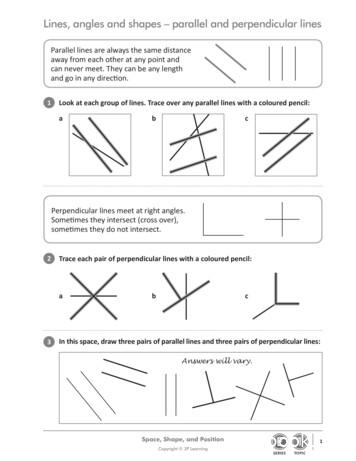Simulating Transmission Lines
SPICE Simulation of Transmission Linesby the Telegrapher's MethodPart 1: Putting the Telegrapher's Equations into a CircuitRoy McCammon, Senior Engineer, 3M Communication Markets DivisionUsers of SPICE have used two methods to simulate transmission lines: use one of SPICE's built in transmission linemodels or use a series of lumped component sub-circuit approximations. Neither method has been completely satisfactory.Neither method directly addresses the fact that some of the line parameters are functions of frequency.SPICE has two transmission-line components: T, the lossless transmission-line component; and O, the lossy transmissionline component. The lossless line simulates only delay and characteristic impedance. For the lossy line; you must enter theprimary line parameters, but at this time it is not possible to have all four primary parameters non-zero at the same time.Furthermore, it is only good at a single frequency or at best a narrow band of frequencies because real line parameters arefunctions of frequency and the ones in the O component are constants.Δ length of segment.repeatsΔ x LωΔ x GωΔ x RωΔ x CωΔ x LωΔ x GωCω capacitance in farads/ kftGω conductance in Ω-1/ kftΔ x RωΔ x CωΔ x LωΔ x GωΔ x RωΔ x CωLω inductance in henries/ kftRω resistance in Ω/ kftFigure 1. Primary line parameters.repeats
Lumped-circuit modeling uses a series of lumped-element subsections as shown in Figure 1. Each line parameter ismultiplied by the length of the section. The fact that the line parameters are dependent on frequency is emphasized by thesubscript of ω. Frequency dependence has been modeled by replacing some components with a parallel ensemble oftuned components with staggered center frequencies (not shown in the figure). Usually, only the variation resistance ismodeled.Finally, the two-way delay (time from source to load and back again) of each sub-circuit must be short with respect to therise times of the signal. For example, if the rise time was 50 ns, the delay of the lumped component sub-circuit should beless than about 10 ns, which for typical twisted pair cable is the delay of about three feet. A 1000-foot line would requireapproximately 300 lumped-component sub-circuits!There is a better way, one which requires only about two-dozen components, regardless of the length or bandwidth of thetransmission line. We will call it the Telegrapher's Method and the sub-circuit we create to implement it will be called theTelegrapher's Model or TM. By the end of this article, we will have a SPICE sub-circuit that will implement theTelegrapher’s method with full frequency dependence and will be as easy to use as the built-in components.The TM two-port modelFigure 2 depicts a two-port equivalent circuit model of the solutions of the Telegrapher's Model. By using Thévenin andNorton equivalents, many different depictions are possible. This particular depiction will be called the canonical two-port.In this model, P1, P2, Z1 and Z2 are frequency dependent and will be implemented with Laplace components. P1, P2(propagation functions) account for loss, delay, dispersion and anything that happens to the signal in transit. The Z1, Z2(the characteristic impedances) and the voltage doublers A1 and A2 account for the interaction of the transmission linewith the external environment. As drawn, Z1 and Z2 would be implemented with a "G" component (a voltage dependentcurrent source) and P1 and P2 would be implemented with an "E" component (a voltage dependent voltage source). Theterm "Laplace component" will be used to mean either the G or E components with the Laplace option.
VfiIinViVg1ZiA12Z1ωVboD2P1FωP2FωVfoIoutVo2A2 Z2ωD11ZoVbiFigure 2. Canonical two-port representation of the solutions of the Telegrapher's EquationsLet's examine this model to if it at least qualitatively behaves as we would expect. We know that if a transmission line isperfectly matched at the load then there will be no reflections from the load. A perfect match means Zo Z2ω. Zo and Z2ωform a voltage divider which divides exactly by 2.Let's start with the node Vfo. That voltage is doubled by A2 and then the voltage divider divides it by 2, so we know thatVo Vfo. The inputs of difference amplifier D1 see Vfo on one input and Vo on the other. These signals exactly cancel sothe output of D1 is zero and there is no reflection. Since the output of D1 is zero, the output of P1 and the output of A1 isalso zero. Let's move our focus back to the node Vi. Since Vbo (the output of P1) is zero, the output of D2 is just Vi. Theoutput of P2 (Vfo) is just Fω x Vfi and we have already determined that Vo is exactly equal to Vfo so we know now thatVo/Vi Fω. Fω is just the transfer function of a perfectly terminated transmission line. That works.What if we now let Zi Z1ω, let Zo become infinite (open), and let Vg be a 1-V step? This configuration, called seriestermination, is often used to drive logic when there is a single transmitter and a single load. Initially all nodes including theoutput of A1 are zero. Vg generates a one-volt step. Zi and Z1ω form and exact divide by two divider so Vi is a ½-V step.D2 sees this ½-V step on its positive input and zero on its negative input, so its output it also a ½-V step. This is input toFω which accounts for delay, dispersion and attenuation.
Just for this case, let’s suppose that Fω is just a pure 150-ns delay without dispersion or attenuation. So, 150 ns after theinput step occurs, a ½-V step comes out of P2 at node Vfo. It gets doubled to 1 V. There is no divider, so the load sees a1-V step even as the input is a ½-V step. D1 sees Vo (a 1-V step) at its positive input and Vfo (½-V step) at its negativeinput, so its output is a ½-Vstep. P1 delays that by another 150 ns, at which time its output, Vbo, produces a ½-V step.This is doubled to a 1-V step by A1. Vi rises from ½ V to 1 V. D2 now sees 1 V at its positive input and ½ V at its negativeinput, so it produces ½ V. But it was already producing ½ V, so nothing changes at the output of D2 so there are no moreevents. The reflection from the load was absorbed by the matched impedance at the source side. To recap, we see theinput rise from zero to ½ V. 150 ns later we see the output rise to 1 V. Finally, 150 ns after that, the input rises to 1 V andthen nothing else happens. This all agrees with experience.But what about the doublers? Transmission lines are just wire and plastic. There are no amplifiers in there. Suppose therewas an ideal, lossless 50-ohm transmission line with a 2-V, 50-ohm source and a 50-ohm load. Zi, Z1, Z2 and Zo all have1 volt across them and they all dissipate 20 mW for a total of 80 mW. But, the source is only providing 40 mW. How canthis two-port be accurate? It does not even conserve energy.Is the two port accurate? The answer is yes and no. The two-port only promises to model the transmission line's effect onthe external circuit. It makes no promise that there is anything like the model inside the transmission line. The modelabsorbs and generates energy from nowhere, but that is OK because energy is conserved in the external circuit. Yes, it isan accurate model of the transmission line's effect on the rest of the circuit, by which we mean the voltages and currentsat the two ends of the model are the same as an actual transmission line.The telegrapher's equationsIn the circuit of Figure 2, the P1 and P2 are just voltage-dependent voltage sources and could be replaced with a SPICE Ecomponent. Impedance, like Z1 or Z2 can be thought of as a component that adjusts its pass current as a function of thevoltage across it. In other words, impedance can be thought of as a voltage-dependent current source. Z1 and Z2 can beimplemented with a G component that has its output connected to its input. This circuit, as drawn could be directlysimulated, if we only knew Z(s) and F(s).Fortunately, that problem was formulated and solved in the late 19th century by Oliver Heaviside. The equations arederived from the incremental model in Figure 1 by mathematically letting the length of each segment approach zero. Thatproduces a second order differential equation that can be solved. The solutions for Z and F are:
1a.1b.γ(s) (Rω sLω ) (Gω sCω )1c.1d.x length of the transmission line.(Refer to Reference 1 or 2 to see how these functions are derived.)Rω, Lω, Gω, and Cω are the previously defined primary parameters of the transmission line. We would now be finished,except that the primary parameters are (possibly) functions of frequency.Understanding the solution to the telegrapher's equationsZ(s) is called the characteristic impedance. It has an explicit frequency dependence caused by the "s" term and an implicitfrequency dependence indicated by the ω subscripts on Rω, Lω, Cω and Gω which means each of the parameters is(potentially) also a function of frequency. There are several definitions of characteristic impedance that are all equivalent:1. It is the impedance seen looking into an infinite length of transmission line.
2. It is the impedance that must be used to terminate the line to avoid reflections.3. It is the impedance seen looking into a finite length of transmission line that is terminated at the other end by itscharacteristic impedance. So if I have 1000 feet of 50-ohm coax and terminate it with 50 ohms at the load and measurethe impedance at the source end, it will be 50 ohms.Fω is called the transmission or propagation function. If the transmission line is terminated by its characteristicimpendence, then the ratio of its output voltage to its input voltage is F(s). i.e. (Vo/Vi) F(s). If F(s) and Vi are known, thenVo F x Vi. The form of F may not be familiar. Clearly, it is a function of length (x), but it may look unusual. γ(s) (alsoknown as the "propagation constant" even though it is not a constant) is a square root of a complex number, and so, ingeneral, γ(s) is also a complex number. For convenience let α(s) and β(s) be the real and imaginary parts of γ(s), i.e.2a.where α and β are purely real. Now we can rewrite:2b.The e-xα term is just the exponential of a real number. As x gets larger, e-xα gets smaller, which means as the transmissionline gets longer, the attenuation increases. e-xα accounts for the loss in the transmission line. The loss is xα with α beingthe loss in nepers per unit length ( 1 neper 8.67 dBs).The e-xjβ term is the exponential of a purely imaginary number and is equal to cos(-xβ) j sin(-xβ). This simply means thatthe phase shift between input and output is xβ in radians per unit length. Obviously, the longer the transmission line thegreater the phase shift. A phase shift of xβ is equivalent to a delay at a particular frequency of d xβ/ω which increasesproportionately to length as the transmission line gets longer (just what we would expect).
In the next part of this article we will show how to put frequency dependence into the solutions of the Telegrapher'sEquations and then in the last part we will pull it all together into an easy to use sub-circuit.References1. Engineering Electromagnetics, 4th edition by William Hayt, 1981. Chapter 12, section 1, "The Transmission LineEquations".2. Wikipedia.org, "Primary line constants", "telegrapher's equations" and "propagation constant".3. Subscriber Loop Signaling and Transmission Handbook, by Whitman D. Reeve, 1995, IEEE Press.4. DSL Simulation Techniques and Standards Development for Digital Subscriber Line Systems, by Walter Y. Chen, 1998,Macmillan Technical Publishing.5. Engineering Electromagnetics, 4th edition by William Hayt, 1981. Chapter 12, section 3, "Transmission-LineParameters".6. Electric Transmission Lines, by Skilling, 1951. Chapter 7.7. Fields and Waves in Communication Electronics, by Ramo, Whinnery and van Duzer, 1965. Chapter 5.8. Home Networking Basis: Transmission Environments and Wired/Wireless Protocols, Chapter 2, section 1.2, by WalterY. Chen, 2003, Prentice Hall.Resources1. Linear Technology Corporation LT Spice IV download available with a very generous /ltspice.jsp2. Yahoo user's grouphttp://tech.groups.yahoo.com/group/LTspice/
About the authorRoy McCammon is a senior engineer with 3M's Communication Markets Division, and agraduate of the University of Texas Department of Electrical Engineering. He has operated a satellite tracking station inAntarctica, designed astronomical instruments and telescope servos, and has spent the last 28 years designing testequipment used by telecommunications providers and thinking about transmission lines. His interests include dancing thetwo-step, pushing miniature battleships around a table top, and simulations.
SPICE has two transmission-line components: T, the lossless transmission-line component; and O, the lossy transmission-line component. The lossless line simulates only delay and characteristic impedance. For the lossy line; you must enter the primary line parameters, but at this time it is
Waves on Transmission Lines 4 Waves on Transmission Lines After completing this section, students should be able to do the following. Name several transmission lines. Explain the di erence between phase shift and time delay of a sinusoidal signal. Evaluate whether the transmission line theory or circuit theory has to be
The RAND function in the DATA step is a powerful tool for simulating data from univariate distributions. However, the SAS/IML language, an interactive matrix language, is the tool of choice for simulating correlated data from multivariate distributions. SAS/IML software contains many built-in functions for simulating data from standard .
1. Lines that do not intersect are parallel lines. 2. Skew lines are coplanar. 3. Transversal is a line that intersects two or more lines. 4. Perpendicular lines are intersecting lines. 5. If two lines are parallel to a third line, then the two lines are parallel. You have just tried describing parallel and perpendicular lines. In
Skew Lines Skew lines are lines that are and do not . In this diagram, planes R and W are parallel. DEand FGare lines. Perpendicular lines are not skew lines, because they're in the same . Parallel lines are skew lines,
ZF Transmission Service Manual 5 2 Transmission System 2.1 Transmission Introduction 2.1.1 General Overview of the Transmission The ZF power gearshift transmission is composed of the hydraulic torque converter and rear-mounted countershaft transmission with multi-sheet friction clutch. The SDLG 938L、
Parallel and 3 Perpendicular Lines 3.1 Identify Pairs of Lines and Angles 3.2 Use Parallel Lines and Transversals 3.3 Prove Lines are Parallel 3.4 Find and Use Slopes of Lines 3.5 Write and Graph Equations of Lines 3.6 Prove Theorems About Perpendicular Lines In previous chapters, you learned the following skills, which you’ll use in
Look at each group of lines. Trace over any parallel lines with a coloured pencil: Lines, angles and shapes – parallel and perpendicular lines 1 2 3 Parallel lines are always the same distance away from each other at any point and can never meet. They can be any length and go in any direc on. ab c ab c Perpendicular lines meet at right angles.
Kindergarten and Grade 1 must lay a strong foundation for students to read on grade level at the end of Grade 3 and beyond. Students in Grade 1 should be reading independently in the Lexile range between 190L530L.























